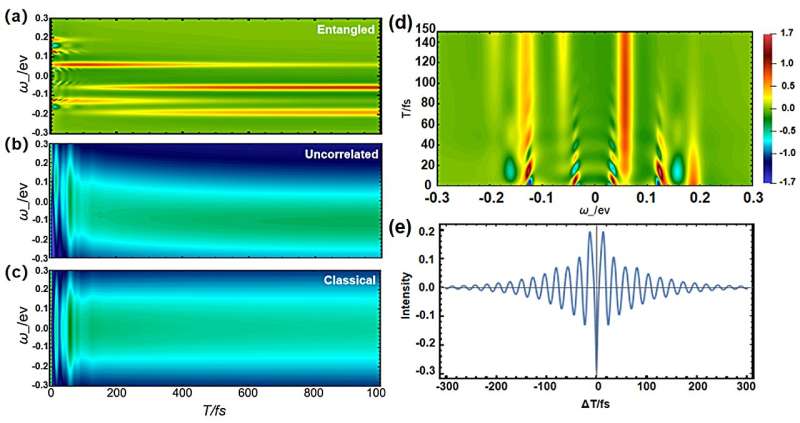This article has been reviewed according to Science X's editorial process and policies. Editors have highlighted the following attributes while ensuring the content's credibility:
fact-checked
peer-reviewed publication
trusted source
proofread
High-speed camera for molecules: Entangled photons enable Raman spectroscopy

In recent years, two cutting-edge technologies have rapidly gained momentum: quantum entangled light sources and ultrafast stimulated Raman spectroscopy.
Quantum entanglement is a unique phenomenon rooted in the principles of quantum mechanics, where particles exhibit instantaneous correlations over vast distances. This field has garnered significant attention in quantum communication, quantum sensing, and quantum computing, even receiving the Nobel Prize in Physics in 2022.
Conversely, stimulated Raman spectroscopy represents a modern analytical method used to study molecular vibrational properties and interactions, offering valuable insights into molecular fine structure. Its applications span various domains, including chemical analysis, biomedical research, materials science, and environmental monitoring.
By combining these two techniques, an exceptionally powerful analytical tool for studying complex molecular materials emerges.
In a new paper published in Light: Science & Applications, a team of scientists, led by Professor Zhedong Zhang and Professor Zhe-Yu Ou from Department of Physics, City University of Hong Kong, Hong Kong, China, developed a microscopic theory for the ultrafast stimulated Raman spectroscopy with quantum-light fields.
This innovative technique leverages the quantum advantages of entangled photon sources to enhance both the temporal and spectral resolution of spectroscopic signals. Moreover, it enables "high-speed imaging" of ultrafast processes occurring within molecular systems. This article aims to guide readers through this groundbreaking concept step by step.
What is stimulated Raman spectroscopy?
Stimulated Raman scattering, as a member of the Raman process family, represents a typical phenomenon in multi-photon interactions, closely intertwined with quantum-light fields. It is based on the interaction between incident light and sample molecules, resulting in a frequency shift of the scattered light. This process involves energy transfer between incident light and molecules, with the frequency shift of the scattered light being correlated to the molecular vibrational energy levels.
The key breakthrough of stimulated Raman spectroscopy lies in its ultrafast processing capabilities. Traditional Raman spectroscopy requires significant data acquisition time, whereas stimulated Raman spectroscopy utilizes ultrashort laser pulses to rapidly acquire an extensive set of data points, facilitating the swift retrieval of crucial molecular information.
Why quantum entangled photon sources?
Quantum entangled photon sources serve as a vital component in stimulated Raman scattering, a two-photon process. These sources provide pairs of entangled photons that induce stimulated Raman scattering when interacting with matter.
Furthermore, quantum entangled photon sources possess non-classical properties, such as correlations between photon pairs in terms of time, frequency, or polarization. This breaks the limitations imposed by classical light and indeed significantly enhances the frequency and temporal resolution of spectroscopic signals.
The authors highlight several advantages of utilizing entangled photon sources, stating that molecules actively serve as beam mixers for Raman pump and probe fields, rather than acting as passive beam splitters for light scattering alone.
Leveraging entanglement, quantum ultrafast stimulated Raman spectroscopy achieves a super-resolved spectrum with time-frequency scales beyond classical bounds. Additionally, multi-photon quantum interference leads to unprecedented selectivity in spectroscopic signals, allowing selective transition pathway to molecular correlation functions.

'High-speed camera' for molecules
Certain molecular systems exhibit ultrafast processes, such as electron transfer and energy redistribution, occurring on the femtosecond timescale (10-15 seconds). Understanding these rapid motions is crucial for advancing imaging devices, energy conversion, and quantum computing. However, the study of these ultrafast processes has been impeded by limitations in time and energy scales.
In this study, researchers can tune specific parameters of nonlinear processes (such as the spectral width of the pump light and the thickness of the nonlinear crystal) to generate entangled photon pairs with femtosecond-level correlation while preserving their energy (frequency) correlations.
These generated photon pairs meet the energy transfer conditions required for stimulated Raman scattering. When this energy transfer process couples to the ultrafast processes occurring in photon-sensitive molecules, the corresponding signal carrying the information of the process appears in the spectra, enabling high-speed imaging of molecules.
Outlook of quantum spectroscopy
Future advancements in quantum spectroscopy are anticipated to yield profound breakthroughs in the field of quantum physics and quantum control at room temperature. These advancements will also drive the development of more efficient and stable quantum light source generation technologies, injecting new vitality into areas such as optical communication, quantum computing, and quantum sensing.
Additionally, the highly efficient and accurate spectral measurement and analysis methods derived from quantum spectroscopy are expected to play pivotal roles in diverse fields, including materials science, chemical reactions, and biomedical research. This research provides a mere glimpse into the potential of quantum spectroscopy.
By harnessing this technique, deeper insights into molecular structural analysis and dynamic observation can be obtained, propelling significant progress in related domains.
More information: Jiahao Joel Fan et al, Entangled photons enabled ultrafast stimulated Raman spectroscopy for molecular dynamics, Light: Science & Applications (2024). DOI: 10.1038/s41377-024-01492-4
Journal information: Light: Science & Applications
Provided by City University of Hong Kong





















